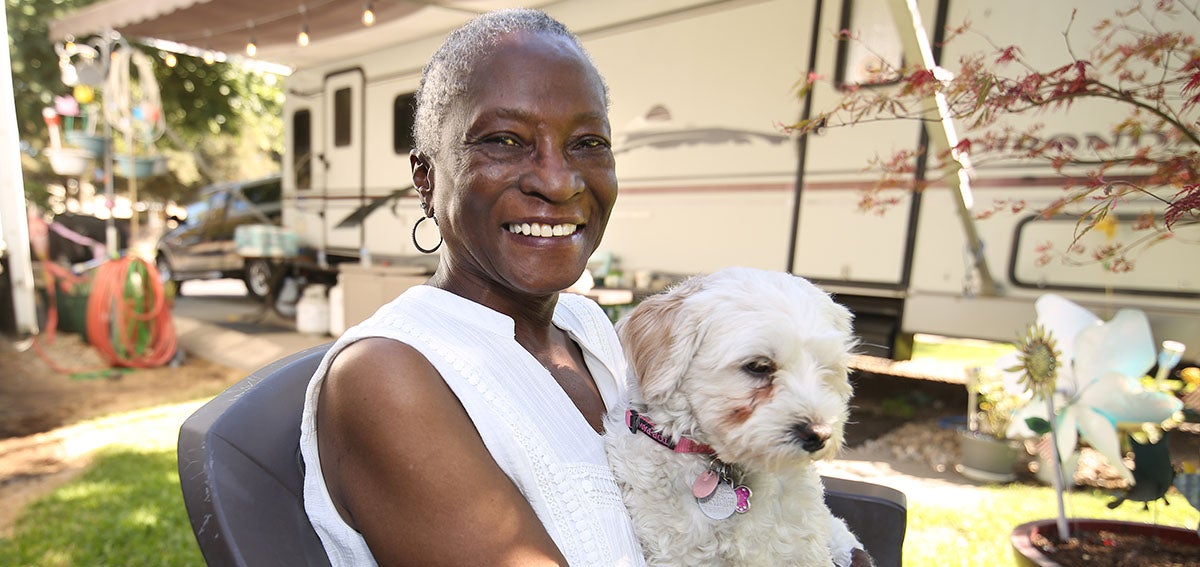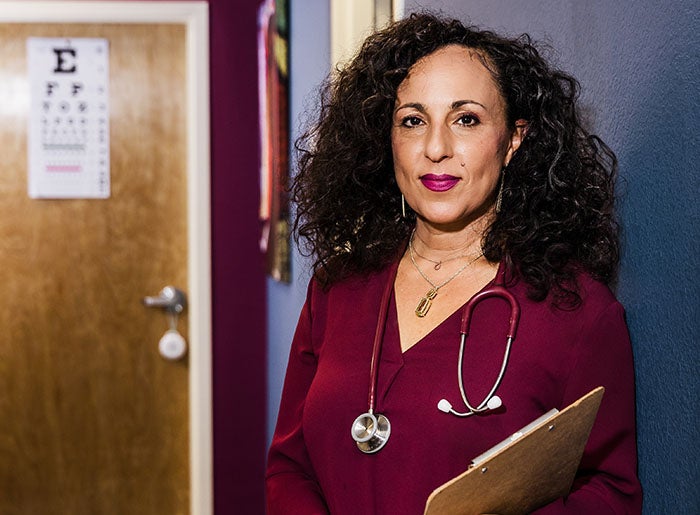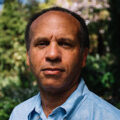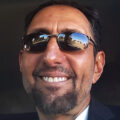[ad_1]

What ever happened to the independent practitioners — those pillars of primary care and community trust who cared for generations of Black families?
|
Listening to Black Californians In 2021, CHCF funded a major research project to understand the health and health care experiences of Black Californians. The Phase I report summarized in-depth interviews with 100 Black Californians that took place in the summer of 2021. Here are the key findings:
Learn more about the Listening to Black Californians project. |
Anna Cahill remembers them well. When she was growing up in the 1950s in segregated Spartanburg, South Carolina, the streets of the city’s south side were crowded with Black-owned restaurants, banks, retail stores, and two small medical practices.
She also remembers, though less fondly, how her asthma sometimes grew so severe that she required medical attention, which appeared in the form of one of those south-side doctors knocking on her family’s front door. “The doctor would come to our house, give me a shot, and I was good,” said Cahill, who now lives 40 miles north of Fresno in the small city of Chowchilla. Asked to compare her experiences then with the modern health care system, Cahill exhaled as if releasing pent-up frustration. “For me, going to the doctor now is like a cattle call,” she said.
From house call to cattle call — strong words, indeed. What could have changed in the health care system since Cahill was a youngster to trigger such a negative reaction? She is one of many respondents expressing similar sentiments in Phase I of Listening to Black Californians, a CHCF study examining patients’ experiences with racism in the health care system.
Perceptions of racial and class bias may have contributed, but another factor plays a less visible and equally important role: sweeping changes in health care financing and delivery over the past 40 years. While these changes were intended to reduce costs and improve quality, they have had a multitude of unintended side effects, including driving out most of the small private medical practices long relied on by Black Californians.
Small Practices Reflected Neighborhood Communities
In the decades after World War II, the health care system was far more decentralized than it is today. It was also segregated. Small medical practices reflected the nation’s stark housing segregation, providing care to families living within a certain neighborhood, area, or racial or ethnic community. Commonly staffed by a doctor and a nurse, these practices were a staple of American life, providing checkups, vaccinations, and routine primary care.

The rise of large private practices and multibillion-dollar hospital networks were still years away.
Small practices had thrived for many decades because they were good at two key things: delivering prompt treatment and building bonds of trust with patients. The success of this model was evident in the longevity of many practices. In Palo Alto, for instance, from 1963 to 1998, partners Andrew White, MD, and James Lockhart, MD, were the go-to physicians for Black families living in San Mateo and Santa Clara Counties.
“Both were well-trained, old-fashioned doctors who just wanted to take care of their community, regardless of anyone’s ability to pay,” said White’s daughter, Tamera White, in a remembrance after his death in 2009 at age 87. “Theirs was one of the few private practices on the Peninsula to accept Medi-Cal, and they were even known to accept collard greens and barbecue as payment.”
Long-Term Relationship
In San Francisco, Black Californians of a certain age still warmly recall Arthur Coleman, MD, who in 1948 opened a solo practice in the city’s Bayview-Hunters Point neighborhood. During 54 years of practice there, Dr. Coleman treated San Franciscans, their children, and sometimes their grandchildren. The long-term relationships they developed with individuals and families in their care tended to build high levels of physician-patient trust, the bedrock of any successful care model.
Aside from the white coat and stethoscope, physicians like Coleman, White, and Lockhart were in many ways like the local plumber or electrician — the neighborhood professional you couldn’t live without. But the personal care relationship built with their patients placed them in unique positions of significant trust. This allowed them to play a secondary role as an informal support figure, perhaps forgoing fees to help a patient down on his luck, connecting an out-of-work patient with a job lead, or giving encouraging words to a husband and wife experiencing marital problems. Trust tends to support better health outcomes for all patients. For families struggling financially, knowing that no financial hardship would interrupt their access to medical care could be a lifeline.
Over the last decades, the way medicine is set up as a business has led to a super concentration of health resources in affluent communities.
—David Carlisle, MD, PhD, Charles R. Drew
University of Medicine and Science
The potency of strong bonds of trust between physicians and patients should not be underestimated. In Phase I of Listening to Black Californians, many respondents described an ideal system of care built on a relationship with compassionate providers who actively listen and engage with them as patients. The long-term erosion of that trust is an important part of what animates Anna Cahill’s nostalgia for the health care system of her youth.
An Unsatisfying System
So how did health care in this country evolve into a system that so many patients find wanting? Four forces began driving major changes in the way care is delivered: rising costs and fees, advances in technology, increased regulation, and the proliferation of treatment advances. These shifts created an array of side effects, including worsening the economics of small practices, altering the geographic distribution of physicians, and influencing which specialties and subspecialties young doctors selected for their own clinical practices.
First, skyrocketing medical costs began putting pressure on patients’ wallets, fueling the view that patient care needed to be more systemically managed. Second, high-tech diagnostic tools, such as MRI and CT scanners, made giant leaps forward in spotting signs of early cancers, heart disease, and myriad other conditions. While these powerful tools entered the system slowly, the astronomical cost of using them could only be borne by large hospital systems and academic medical centers.
Third, changes in fee structures also made things difficult for small medical practices. David Carlisle, MD, PhD, president and chief executive officer of Charles R. Drew University of Medicine and Science in Los Angeles, said the structure of Medicaid and Medicare reimbursements to small practices became insufficient for economic survival. Carlisle, who is a member of the CHCF board of directors and an advisory group member for Listening to Black Californians, noted that in addition to the rising costs of equipment, federal regulations now mandate extensive record-keeping, data analysis, and reporting. These require expensive IT infrastructure that is prohibitively expensive for small practices.
For a long time, the advantages of small practices, including the high-touch care and familiarity with each patient’s socioeconomic circumstances, obscured the model’s weaknesses. But most were effective only at delivering primary care, and few were equipped for specialized work, complicated procedures, or state-of-the-art data-driven quality improvement practices that make medicine more effective.
During the late 1980s, many of the small venerable practices began to thin out. Others consolidated or were bought out by big health care entities. The fee structures steered many young physicians toward higher-earning specialties in more affluent areas. Practices serving low-income neighborhoods became more difficult to staff.
Super Concentration
“Today, just as it was for me when I was coming up 35 years ago, there are medical students who want to serve underprivileged communities,” Carlisle said, “but over the last decades, the way medicine is set up as a business has led to a super concentration of health resources in affluent communities.”
Over the last two decades, the number of physicians in California has been on the rise. Despite this, urban Black communities like the Watts neighborhood in southern Los Angeles, as well as suburban and rural counties with growing Black populations, find themselves with few practical ways to access care from providers they know and trust.
Noha Aboelata, MD, said she is careful to bring small-practice energy into clinical appointments at Roots Clinic. She doesn’t hurry patients, and the all-Black medical staff invest time in building connections with each patient.
It is easy to understand how a patient accustomed to care at a familiar small practice might not embrace a setting with high patient volumes where time demands and other constraints on providers never let up. In the soon-to-be-released statewide survey of Listening to Black Californians, 22% of respondents and nearly one-third of Medi-Cal enrollees reported that people from other racial and ethnic groups were unfairly prioritized ahead of them during health care visits.
If small practices were once a lifeline, particularly for households with low incomes, then it is fair to ask if that lifeline has been replaced. While most small practices are gone, new types of providers have appeared, including urgent care facilities and Federally Qualified Health Centers (FQHCs). In many cases, these centers provide higher levels of care than the old neighborhood practices could. They are staffed by physicians across multiple specialties, backed by more advanced diagnostic capabilities, and often hire from the communities they serve. That creates jobs and nurtures trust.
Even though small practices are disappearing, the core needs they meet still exist. Los Angeles medical executive Positron Kebebew, MD, MPH, began her career at a clinic in San Francisco’s Hunters Point neighborhood during the 1980s. That clinic, she recalls, attracted Black patients from throughout the city. Although the clinic is now closed, Kebebew said neighborhood practices are still a powerful draw. “There are many members of our community who like the trust and the familiarity,” she said. “They don’t have to worry about bias. Often the physicians had been there for a decade or more.”
The Roots Model
Roots Community Health Center, which originally launched in East Oakland in 2008 as a think tank, looked at the lessons learned from the small practice model, studied the variables that face FQHCs, and put clinical care at the hub of broader community services that include workforce training, housing assistance, behavioral health supports, and more. Roots now has two Oakland clinics, a South Bay headquarters in San Jose, and a mobile service.
Roots founder and CEO Noha Aboelata, MD, an Oakland native who serves on an advisory board for the Listening project, acknowledges that Roots’ focus on social determinants of health is what makes the clinical health care services stick. “When I came out of medical school, I went to work at an FQHC. Many of my patients were very sick. But the problems they had were not just medical. I said, ‘We’ll never get ahead of this. The system is not set up to handle this.’”
The wraparound service model she and her colleagues built at Roots is based on a few solid concepts that community development professionals have always known: Without safe, stable housing, a job that pays a living wage, familial support, and the absence of substance use disorders, improvements in health status are unsustainable. Roots services fall into social service territory, not much different from the small medical practices of yore but on a vastly larger scale. Aboelata said she is careful to bring that small-practice energy into her clinical appointments. She doesn’t hurry patients in and out, and the all-Black medical staff spend lots of time building connections with each patient.
The economics of this care model require Roots to raise private and public funds to maintain seven MDs and dozens of social service professionals to serve the 700 or so patients who visit Roots every month. Despite the demands of its fundraising efforts, Roots is betting it can still have measurable long-term impact on the people of East Oakland.
“Communities used to be more cohesive and provide support to their members in difficult times,” said Katherine Haynes, MBA, the CHCF senior program officer overseeing the Listening project. “Roots is trying to fill some of the holes that exist in the social fabric. This is fantastic work they’re doing, but we’re asking health care to handle more and more with the limited resources they have when many of the problems we see are failures of other sectors.”
Decades of changes to care delivery have threatened the survival of small practices, but as the Roots model demonstrates, what patients want has remained constant. As many participants made clear to researchers in interviews for Listening to Black Californians, without trust, there is nothing.
The final report of the Listening to Black Californians research, including Phases II and III, is expected to be published in early fall 2022.
[ad_2]
Source link



